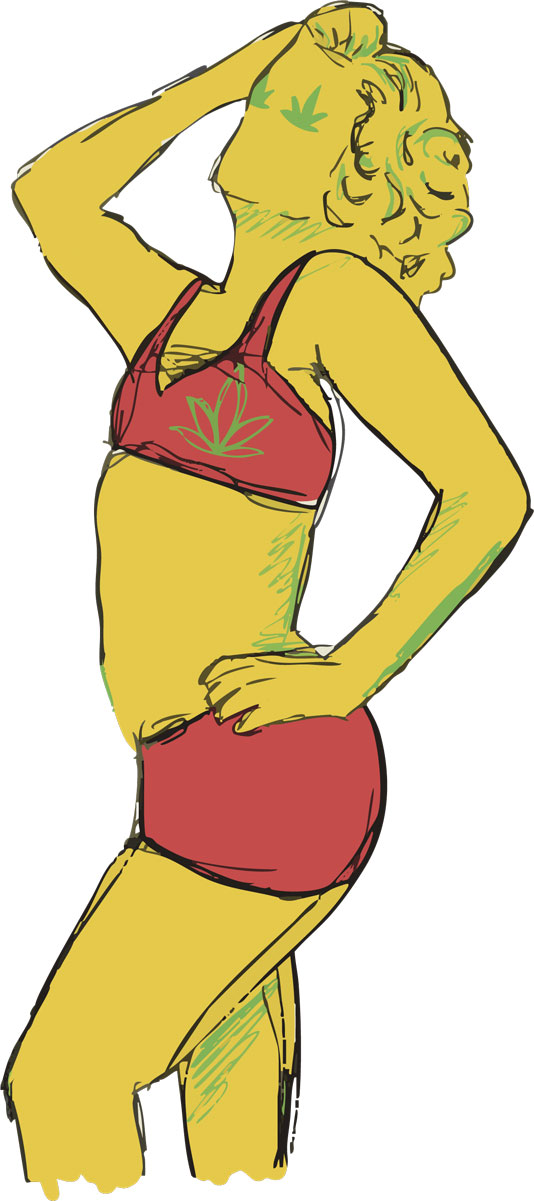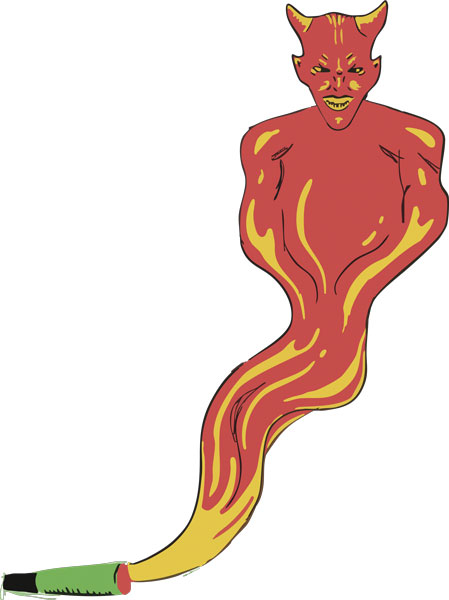
Ava Klooster
On top of the colorful leaves, the awesome sweaters, and the hot drinks, autumn is not complete without the spooky season celebrations. In honor of Halloween and to commemorate this marvelous time of year, let’s light up and reflect upon the history of one of the scariest monsters out there: cannabis. That’s right. Lock your doors. Bolt your windows. To quote Judy Moody and the Not Bummer Summer (2011), “Head for the basement. And if you don’t have a basement — build one.”
Anyone who smokes cannabis, or rather the “burning weed with its roots in hell,” is immediately prone to “debauchery, violence, murder, suicide,” and “The ultimate end of the marijuana addict: hopeless insanity.” At least, according to the trailer for the 1936 public service announcement, Reefer Madness. Reefer Madness is a full-length movie filmed and funded by a small church group. It follows the fictional lives of teenagers as they get introduced to cannabis, before either wildly making out with each other, killing people, laughing and twitching maniacally, or hurling themselves out of windows.
After the film was shot, it was purchased by an exploitation filmmaker who changed its original churchyard name of Tell Your Children to its more gripping title, and also cut in shots of beautiful women running around in their underwear.
Cannabis sounds terrifying, and boy, is it.
Before our hellish Presidents Richard Nixon and Ronald Reagan were using falsified dangers of cannabis and other drugs to blame minority groups for society’s problems as a way to cover up their own missteps, a man named Harry J. Anslinger was doing it before it was cool.
So, remember the Great Depression? Yeah, that was a tough time, but it would have been even tougher without someone to blame. Because unemployment rates were so high, a cultural and political disdain grew for Mexican immigrants who came to the US to find work, to the point where fault was being put on them for the economic crisis. As a result, there was a large push to find any means necessary to send them back to Mexico. According to the Library of Congress, hundreds of thousands of Mexican workers returned to Mexico in the 1930s, either voluntarily with free train tickets or forcefully on suspicion of being Mexican.
During this time, Anslinger was appointed as the founding leader of the Federal Bureau of Narcotics (a major precursor to the DEA) under President Herbert Hoover. According to journalist Johann Hari’s book, Chasing the Scream: The First and Last Days of the War on Drugs, “From the moment he took charge of the bureau, Harry was aware of the weakness of his new position. A war on narcotics alone — cocaine and heroin, outlawed in 1914 — wasn’t enough…They were used only by a tiny minority, and you couldn’t keep an entire department alive on such small crumbs. He needed more.”
At the time, cannabis laws were only barely present and rarely enforced in 16 states, and it wasn’t actually seen as an issue or a danger outside of places with higher usage, such as New Orleans, according to the 1972 paper “American Concern Over Marihuana” by William D. Armstrong and John Parascandola.
 So, by 1936, he decided to stamp his foot down on all drugs, including cannabis, which has long been rumored to have originally entered the US via Mexican farmworkers. Even still, as a result, he was able to kill two — even three — birds with one stone: He could make some progress in his new job (after the dwindling prohibition era, a movement he also had a significant role in); villainize as many Mexican immigrants as possible; and as a bonus, eventually find other ways to racialize the drug (though cannabis had been banned in Mexico since 1920 and many Mexican people viewed it as a dangerous drug — in fact, there is little evidence to support that Mexican people were even using the drug as much as Americans were. Yet, he still heavily associated cannabis use with Native Americans and Black people).
So, by 1936, he decided to stamp his foot down on all drugs, including cannabis, which has long been rumored to have originally entered the US via Mexican farmworkers. Even still, as a result, he was able to kill two — even three — birds with one stone: He could make some progress in his new job (after the dwindling prohibition era, a movement he also had a significant role in); villainize as many Mexican immigrants as possible; and as a bonus, eventually find other ways to racialize the drug (though cannabis had been banned in Mexico since 1920 and many Mexican people viewed it as a dangerous drug — in fact, there is little evidence to support that Mexican people were even using the drug as much as Americans were. Yet, he still heavily associated cannabis use with Native Americans and Black people).
The way he fearmongered cannabis into the public eye was by latching on to sensationalist journalism from 1920s New Orleans and earlier in what he called “The Gore Files.” These pieces typically linked cannabis to violence, insanity, and in the worst cases, fornication. A 1905 article from the LA Times has the headline Delirium or Death: Terrible Effects Produced by Certain Plants and Weeds Grown in Mexico reads: “Not long ago a man who had smoken [sic] a marihuana cigarette attacked and killed a policeman and badly wounded three others…Such occurrences are frequent…People who smoke marihuana finally lose their mind and never recover it, but their brains dry up and they die, most of times suddenly.” Another from NYT in 1925 was titled “KILLS SIX IN A HOSPITAL.; Mexican, Crazed by Marihuana, Runs Amuck With Butcher Knife.”
In 1933, Anslinger had found his golden goose. Victor Lacata from Tampa was a supposedly mild-mannered 21-year-old who murdered his entire family with an axe, all while under the influence of cannabis according to newspaper reports (his toxicology reports actually included zero traces of cannabis, but they did include a diagnosis for “acute and chronic insanity” but of course that was irrelevant to him). Now the cannabis killer is white, meaning that the evil Mexican plant is now affecting your kids. From 1933 to 1937, Anslinger wrote about this instance six times.
By 1936, with the help of congress and the FBN, Anslinger had created widespread fear of our precious plant, thus resulting in tons of newspaper propaganda reports, falsified data and the famed Reefer Madness. In 1937, Anslinger published his most famous piece ever to American Magazine, “Marijuana: The Assassin of Youth.” It opens with the line:
“Not long ago the body of a young girl lay crushed on the sidewalk after a plunge from a Chicago apartment window. Everyone called it suicide, but actually it was murder. The killer was a narcotic known to America as marijuana.”
One month later, the Marihuana Tax Act passed in congress, which controlled and regulated the importation, possession, cultivation and sale of the plant through taxation. This was the first instance of marijuana being regulated in the US, being the first step in a long string of prejudice, Nancy Reagan, economical and political struggles, and racism all associated with marijuana. But, to recall the words of the narrator for Winnie the Pooh, that is an entirely different story for an entirely different day.
So, do any of the “soul destroying reefer” (also a quote from the Reefer Madness trailer) claims have any merit? As long as cannabis is still federally illegal, any definitive research will remain scarce, but here’s what we know. In early 2025, a study out of Canada titled “Convergence of Cannabis and Psychosis on the Dopamine System” found a link between those who suffer Cannabis Use Disorder (which is essentially experiencing symptoms of addiction when using cannabis) and a biological connection to psychosis from the brain’s dopamine system. A frequently cited study from 2008 titled “Cannabis use and the risk of developing a psychotic disorder,” found a large correlation in users with schizophrenia, finding that cannabis use can worsen and exacerbate symptoms.
If there’s anything to take away from this story, it should be three things. The first being that drug enforcement laws, especially those relating to cannabis, are and always have been racially charged. The second is to be freaking careful when you’re ingesting cannabis, knowing that though cannabis has many medicinal properties, it absolutely can worsen negative mental health symptoms. The third is that the scariest Halloween monster of them all is Harry Anslinger (and also, go watch Reefer Madness. It’s public domain so you can access it for free).